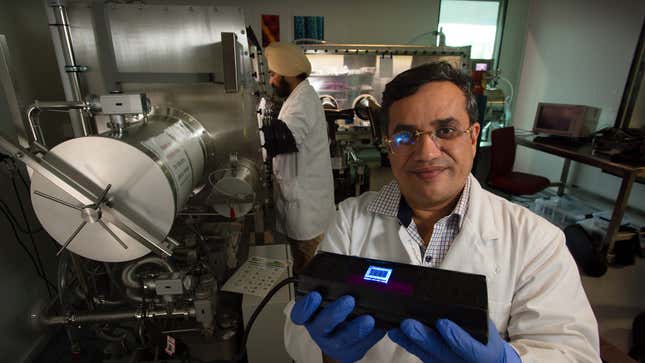
Recycled human hair has been used throughout history for a variety of purposes, but never before has it been turned into OLED displays—until now.
Researchers at Queensland University of Technology (QUT) in Brisbane, Australia used a local barber shop’s donated trimmings to experiment with turning hair strands into carbon nanodots that can glow bright enough to use in a smart device’s display. It’s the first time anyone has been able to make strands of hair luminescent and use them successfully in a light-emitting device.
As QUT details in its blog, professors Prashant Sonar, Ken (Kostya) Ostrikov, and their research team, in collaboration with professor Qin Li of Griffith University, have “developed a method of turning the small hair strands into carbon nanodots, which are tiny, uniform dots that are one-millionth of a millimeter.” Basically, they developed a way to break down hair, and then burned it at 240 degrees Celsius (464 degrees Fahrenheit) to create “flexible displays that could be used in future smart devices.”
Carbon nanodots (also called carbon dots, or CDs) are a new class of quantum dots. If you have seen or own a quantum dot (QD) TV, then you’ve probably noticed how much more vibrant and clear the picture is. That’s because QDs produce pure monochromatic red, green, and blue light. LEDs in those TVs emit blue light rather than white, and the QDs are responsible for creating the red and green light. QDs job are to emit a single color, and they are very good at it.
While CDs can do the same, they are more eco-friendly. They also have low toxicity, biocompatibility, and chemical stability advantages, according to 2019 study in Nature.com’s Science Reports research journal. Using human hair waste that would otherwise end up in a landfill opens up new opportunities for sustainable technology.
Hair is a natural source of carbon and nitrogen, Sonar said in the university’s research blog. To get light-emitting particles, both of those elements need to be present. Because hair is made up of proteins, including keratin, heating the hair up to such a high temperatures leaves carbon and nitrogen embedded in its molecular structure afterward. That’s what makes hair unexpectedly ideal for this application.
The CDs produced from human hair at QUT were not bright enough to use in TV screens, but Sonar said they could be ideal for use in flexible and cheap screens used in wearables and other small smart devices.
Sonar used a smart milk bottle as a hypothetical example. The bottle could have a sensor on the inside to track how long until the milk expires, and a display on the outside to show that information. The small outer display would be made of the CDs created from human hair. Pretty cool, right? (That also sounds easier than connecting a smart device to an app on your phone.)
Now that Sonar and his team of researchers have be able to make CDs from human hair, the next step is to research animal hair. If it works, your dog or cats fur could be used to make the screen on your smartwatch.